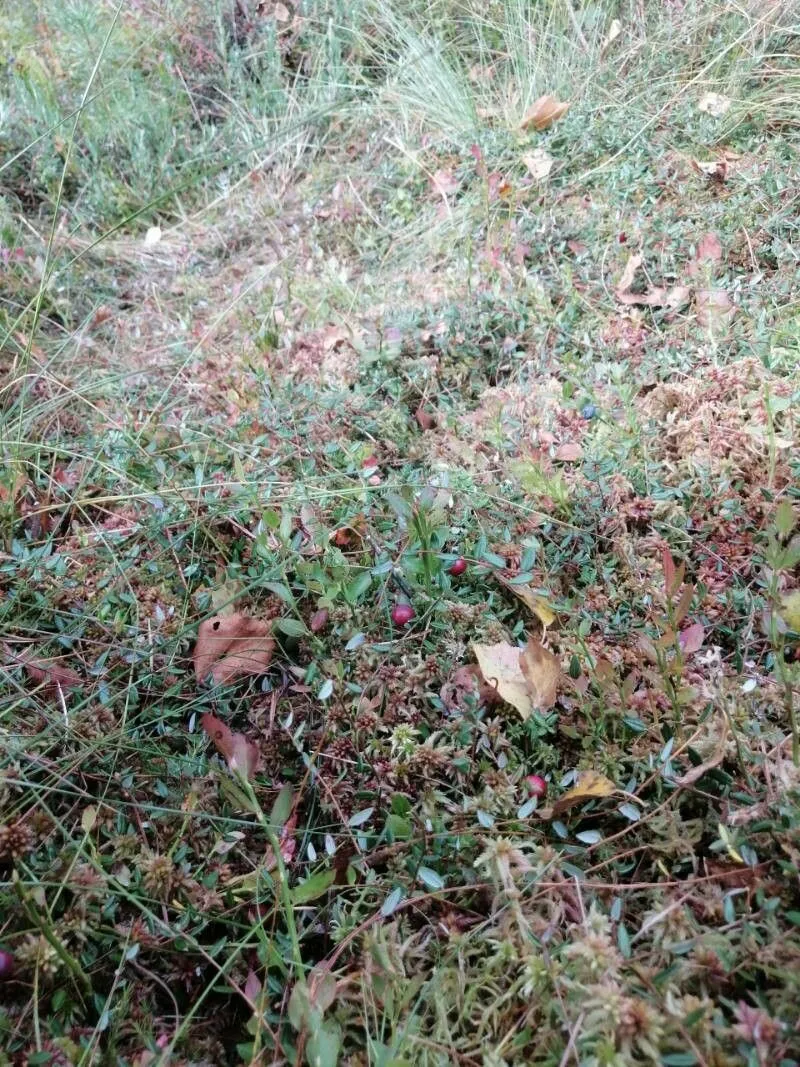
Author: L.
Bibliography: Sp. Pl.: 351 (1753)
Year: 1753
Status: accepted
Rank: species
Genus: Vaccinium
Vegetable: False
Observations: Subarctic & Temp. Northern Hemisphere
The European cranberry, known scientifically as Vaccinium oxycoccos, is a member of the Ericaceae family. It is distinguished by its sprawling, delicate vines that often form dense mats over boggy, acidic soils. This plant thrives in the subarctic and temperate regions of the Northern Hemisphere, exhibiting a remarkable adaptation to its cool, damp habitats.
The flowers of the European cranberry, typically seen in late spring to early summer, are small and pink with a distinctive, reflexed petal structure that adds a touch of delicate beauty to the wetlands. The fruit, which matures by late summer to early autumn, is a small, round, and vibrant red berry. These berries are not only rich in vitamin C but also renowned for their tart flavor, making them a versatile ingredient in culinary applications from jellies to sauces.
First described in 1753 by the renowned botanist Carl Linnaeus in his seminal work Species Plantarum, the European cranberry occupies an important ecological niche. It is a vital food source for various bird species and serves as a critical component of the wetland plant community. Its presence often indicates the health and integrity of its native ecosystems.
The plant’s ability to tolerate and even thrive in the challenging conditions of peat bogs underscores its resilience. Such environments are often marked by poor nutrient availability and fluctuating water levels, yet Vaccinium oxycoccos manages to flourish, contributing to the biodiversity and stability of these unique habitats.
The European cranberry remains a subject of interest not only for botanists and ecologists but also for those in the agricultural and horticultural sectors, who seek to harness its hardy characteristics and beneficial properties. Whether appreciated for its ecological role, its nutritional value, or its aesthetic charm, the European cranberry continues to be a species of significance across its widespread range.
Dan: almindelig tranebær, tranebær
Eng: cranberry, european cranberry, mossberry, small cranberry, bog cranberry, marshberry, swamp cranberry
Deu: gewöhnliche moosbeere, moosbeere
Fra: canneberge commune, airelle canneberge, atocas, canneberge, canneberge à gros fruits, mocôques, petit atoca, petite canneberge
Fin: isokarpalo
Swe: isokarpalo, tranbär, tränjon
Nob: stortranebær
Nno: stortranebær
Nld: kleine veenbes
Cym: llyg eirinen, llygad aeron, llygad eirian, llygad eirin, llygad yr aeron, llygaeren, llygaeron
En: European cranberry, Mossberry, Cranberry, Small cranberry, Bog cranberry, Stuorrâjeggijuŋŋâ, Marshberry, Swamp cranberry, Marsh Whortleberry
Ar: عنب المناقع
Az: Bataqlıq mərcanı
Be: Журавіны звычайныя
Zh: 红莓苔子
Kw: Lus
Hr: Močvarna brusnica
Cs: Klikva bahenní
Da: Almindelig Tranebær, Tranebær
Nl: Kleine veenbes
Et: Harilik jõhvikas
Fi: Isokarpalo
Fr: Canneberge commune, Airelle canneberge, Atocas, Canneberge, Canneberge à gros fruits, Mocôques, Petit atoca, Petite canneberge, Bassin des marais, Brimbelle des marais, Coussinet des marais, Myrtille des marais
De: Moosbeere, Gewöhnliche Moosbeere, Gemeine Moosbeere, Krambeere, Sumpfmoosbeere, Torfbeere
Hu: Tőzegáfonya
It: Mirtillo di palude, Mirtillo palustre
Ja: Tsuru-kokemomo
Kv: Туримоль
Ko: 넌출월귤
Lt: Paprastoji spanguolė
Se: Jeaggemuorji
No: Vanlig tranebær
Nb: Stortranebær
Nn: Stortranebær
Fa: کرنبری باتلاقی
Pl: Żurawina błotna
Ro: Răchițele
Sk: Kľukva močiarna
Sv: Tranbär, Isokarpalo, Tränjon
Uk: Журавлина болотна
Cy: Llygaeren, Llyg Eirinen, Llygad Aeron, Llygad Eirian, Llygad Eirin, Llygad yr Aeron, Llygaeron
Taken Jul 20, 2021 by Oktay Hakkı (cc-by-sa)
Taken Aug 25, 2020 by kendall warlow (cc-by-sa)
Taken Aug 26, 2018 by Reinhard Bachmann (cc-by-sa)
Taken Nov 4, 2022 by Michal Svit (cc-by-sa)
Taken Sep 14, 2022 by Adrian 🇵🇱 (cc-by-sa)
Taken Nov 1, 2022 by Gerd Süssbier (cc-by-sa)
Taken Aug 23, 2022 by Błażej Nowak (cc-by-sa)
Taken Jun 1, 2022 by Sylvain Piry (cc-by-sa)
Taken Jun 1, 2022 by Sylvain Piry (cc-by-sa)
Taken Sep 14, 2022 by Adrian 🇵🇱 (cc-by-sa)
Taken Apr 6, 2015 by EOL − Matt Bowser (cc-by)
Taken Aug 7, 2010 by Tela Botanica − Yoan MARTIN (cc-by-sa)
Taken Jun 1, 2022 by Sylvain Piry (cc-by-sa)
Taken Aug 4, 2009 by Tela Botanica − Yoan MARTIN (cc-by-sa)
Taken Sep 14, 2022 by Adrian 🇵🇱 (cc-by-sa)
© copyright of the Board of Trustees of the Royal Botanic Gardens, Kew.
© copyright of the Board of Trustees of the Royal Botanic Gardens, Kew.
© copyright of the Board of Trustees of the Royal Botanic Gardens, Kew.
Taken May 19, 2022 by Fero Looxi (cc-by-sa)
Taken Jun 20, 2022 by Stasys Sedula (cc-by-sa)
Taken Jun 1, 2022 by Sylvain Piry (cc-by-sa)
Taken Jan 1, 1800 by Tela Botanica − Thierry Pernot (cc-by-sa)
Taken Jan 1, 1800 by Tela Botanica − Thierry Pernot (cc-by-sa)
Taken Aug 15, 2010 by Photoflora – Jean-Luc TASSET (©)
Taken Aug 15, 2014 by Photoflora – Jean-Luc TASSET (©)
Taken Jan 1, 1800 by Tela Botanica − Thierry Pernot (cc-by-sa)
Taken Jan 1, 1970 by Photoflora – L’Abbé COSTE (©)
Taken Jun 20, 2022 by Stasys Sedula (cc-by-sa)
Taken Jan 1, 1800 by Tela Botanica − Thierry Pernot (cc-by-sa)
Taken Jan 1, 1800 by Tela Botanica − Thierry Pernot (cc-by-sa)
Growth habit: Shrub, Subshrub
Ph maximum: 6.5
Ph minimum: 5.5
Light: 7
Atmospheric humidity: 9
Soil nutriments: 1
Family: Myrtaceae Author: (F.Muell.) K.D.Hill & L.A.S.Johnson Bibliography: Telopea 6: 402 (1995) Year: 1995 Status:…
Family: Rubiaceae Author: Pierre ex A.Froehner Bibliography: Notizbl. Bot. Gart. Berlin-Dahlem 1: 237 (1897) Year:…
Family: Sapindaceae Author: Koidz. Bibliography: J. Coll. Sci. Imp. Univ. Tokyo 32(1): 38 (1911) Year:…
Family: Asteraceae Author: A.Gray Bibliography: Pacif. Railr. Rep.: 107 (1857) Year: 1857 Status: accepted Rank:…
Family: Fabaceae Author: Medik. Bibliography: Vorles. Churpfälz. Phys.-Ökon. Ges. 2: 398 (1787) Year: 1787 Status:…
Family: Aspleniaceae Author: (Cav.) Alston Bibliography: Bull. Misc. Inform. Kew 1932: 309 (1932) Year: 1932…